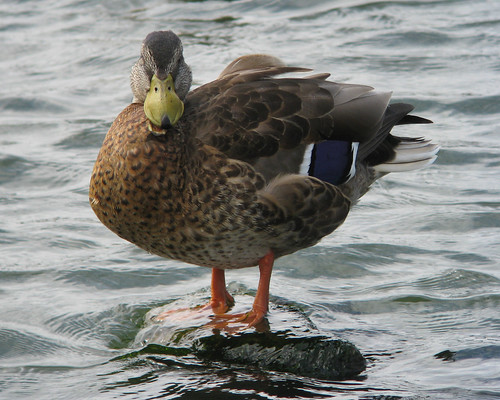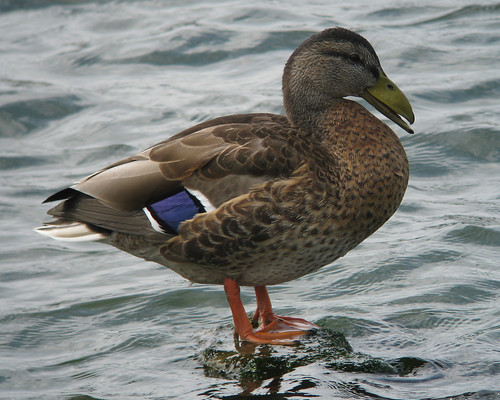Visit most any marina along the Pacific coast of the United States and you will more than likely find two groups of birds to be ubiquitous – gulls and ducks. Thus whenever one sets out to do a little photography of either one of these two groups, a few opportunistic images of the other will more than likely find their way onto the camera’s memory card. So it was with me whilst recently digiscoping the Western and California Gulls gathered at the West Mooring Basin in Astoria, Oregon. Try as I might to focus my attention on the white and grey shapes of the gulls resting on the algae-covered pilings just off-shore, I couldn’t help but occasionally notice movement from one of the chestnut brown ducks paddling along the Columbia River’s gently lapping waters. It was during one of of these occasional diverting glances that I first took note of a particular duck that differed from all the others.
This particular duck, which I initially thought to be simply another Mallard, Anas platyrhynchos, sported a bill that was far larger than it should have been for its species. Knowing that ducks, particularly Mallards, do hybridize, I considered the possibility that the parentage of this particular duck included a Northern Shoveler, Anas clypeata (both species being members of the Genus Anas, the premise seemed entirely reasonable).

However when I focused my spotting scope clearly on the duck, I could see that the reason for my suspicions – the over-sized bill – was not evenly developed. In fact, the lower bill was longer than the oddly curved upper bill. In addition, it seemed possible that the upper bill itself might be either structurally deformed or possibly even swollen (the rhamphotheca, the “sheath of skin” that covers the actual hard, bony structure that makes up the bill, is softer and more supple on waterfowl than on other birds; could it actually swell?).

I have spent some time since these photos were recorded researching possible causes of such an observed bill irregularity. While I have not found much information on swelling of the rhamphotheca, I did note more than one reference to a link between bill deformities in ducks and exposure to Mercury while in the egg. Of course, without the actual duck available for further testing, an accurate explanation isn’t possible. Still, anyone who may have an idea as to what caused this duck’s oddly shaped bill is most welcome to leave a comment with a hypothesis.
If you enjoyed reading this, please consider signing up for The Well-read Naturalist's newsletter. You'll receive a helpful list of recently published reviews, short essays, and notes about books in your e-mail inbox once each fortnight.
